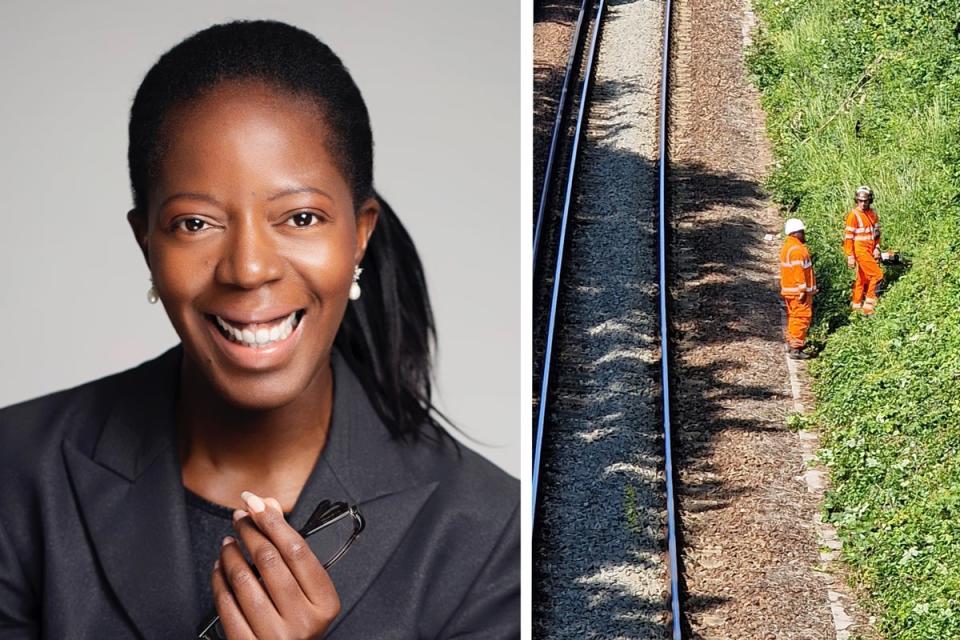Residents dismayed by ‘wanton destruction’ of trees along rail line in Lewisham

Residents in a south London conservation area are outraged by the sudden felling of trees for rail improvements.
Joy Carter was shocked by the scale of the three-mile cull in habitats where 30 species of birds, rare insects and hedgehogs breed.
Network Rail apologised for “letting down” locals who were initially told the latest work would begin this Sunday.
But engineers arrived in force on Thursday to cut down some 50-year-old trees and vegetation within 23ft (seven metres) of the tracks.
Rail chiefs say the management is essential for driver safety so there are no signal blind spots.
It will also prevent delays caused by leaves and branches falling on the line from College Tunnel, near New Cross to Charlton Junction.
But Ms Carter, who has lived in Brockley, Lewisham for 20 years, said: “It’s ridiculous, they’re destroying natural beauty for no reason.
“We moved here because of the conservation area, cleaner air, the woodpeckers, hummingbirds, bats and owls. It was like a proper forest. I’ve never seen a tree fall down on the tracks, so to me this is wanton destruction.
“A letter about the clearance at the weekend arrived on Tuesday but I filmed them starting on Thursday.”
The borough was recently named as one of the worst hotspots in London for killer toxic air.
Ella Adoo-Kissi-Debrah, nine, died in February 2013 from a severe asthma attack directly attributed to the illegally high levels of pollution in Lewisham, where she lived with her family near the South Circular Road.
Comedian and actress Ms Carter added: “Why get rid of trees in this way when we know how good they are for our health?”

Cllr Louise Krupski, Lewisham’s cabinet member for environment and climate action, said: “These railway sidings provide the borough with an important source of biodiversity and tree coverage and include sections of land designated as nature conservation areas by Lewisham Council.
“While we understand that these sort of operational works are necessary to ensure the smooth running of our railways, it is vital that Network Rail’s approach to these works minimises any loss of trees, vegetation or wildlife habitats.
“Although we do not have any formal powers to prevent these works from taking place, we have urged Network Rail to ensure their approach reflects the value the railway sidings provide to the borough in terms of biodiversity and nature conservation.”
Network Rail said it is working with the Zoological Society of London to monitor wildlife at certain locations with the aid of cameras and audio sensors.
It plans to plant 100,000 trees away from rail lines by next year as part of a £1million-plus investment.
Spokesman Chris Denham said: “As well as helping to drive London’s economic growth and providing a clean and green way to travel, London’s railways are important corridors for wildlife and play a role in preserving the capital’s biodiversity.
“Network Rail balances running a safe and reliable railway with protecting wildlife, and that does mean we do need to manage trees carefully, selectively removing some and especially those which are within seven metres of the tracks.

“Trees can obscure signals, cause tracks to settle unevenly, their leaves cause trains to lose grip and in some circumstances trees can also fall in front of trains.
“We carry out an ecological assessment whenever tree management takes place and our team of ecologists across the country is working improve biodiversity on those sites, leaving log piles, ‘dead hedges’ and other places for wildlife to live and move around. In fact, removing trees can improve biodiversity by allowing other plant species to thrive – it’s one of the reasons the railway is home to so many dormice, for instance.
“That said, in Brockley we let our neighbours down by not contacting them soon enough or providing them with a proper explanation of the work.
“We are in the process of writing to them individually to apologise for that.”

 Yahoo Sport
Yahoo Sport 





































